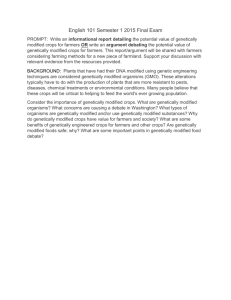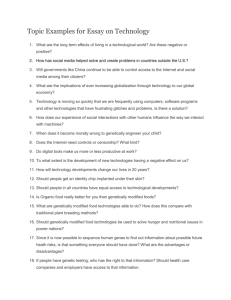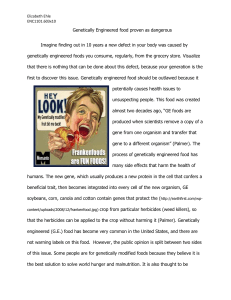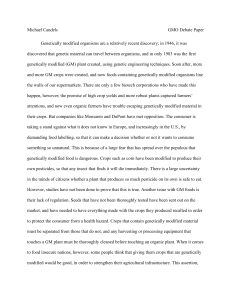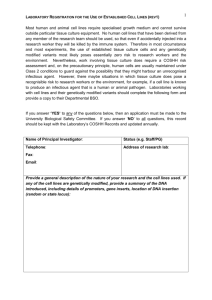Word - College Ready
advertisement
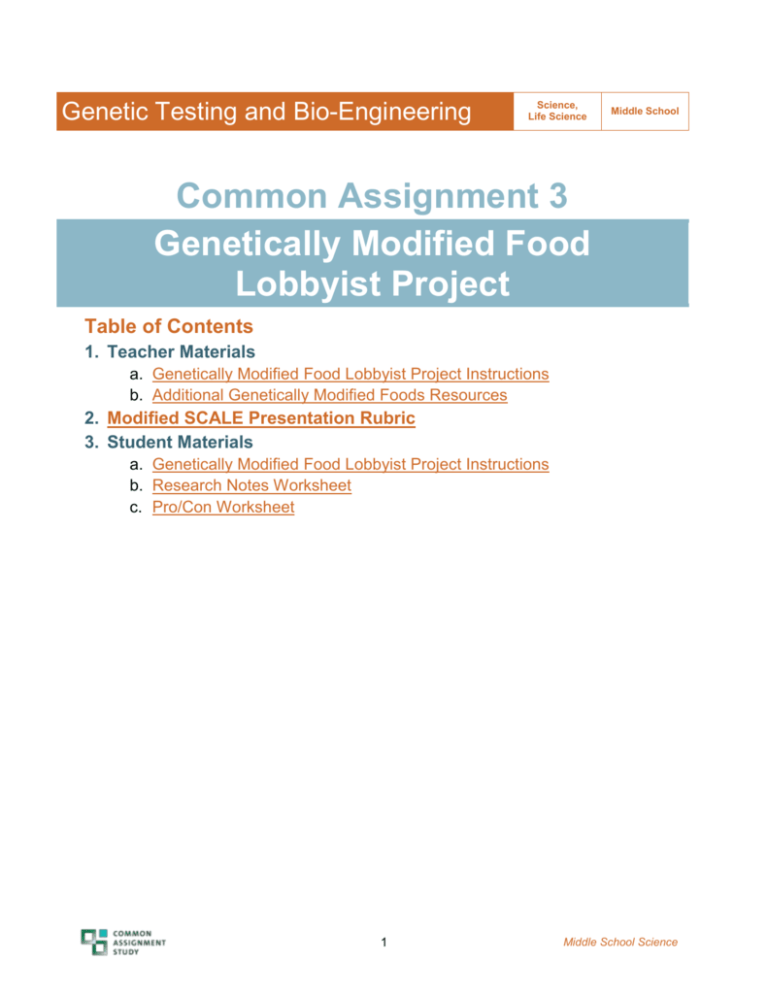
Genetic Testing and Bio-Engineering Science, Life Science Middle School Common Assignment 3 Genetically Modified Food Lobbyist Project Table of Contents 1. Teacher Materials a. Genetically Modified Food Lobbyist Project Instructions b. Additional Genetically Modified Foods Resources 2. Modified SCALE Presentation Rubric 3. Student Materials a. Genetically Modified Food Lobbyist Project Instructions b. Research Notes Worksheet c. Pro/Con Worksheet 1 Middle School Science Genetic Testing and Bio-Engineering Common Assignment 3 Genetically Modified Food Lobbyist Project Learning Targets Students will: Select a company to represent in the Genetically Modified Foods Debate, and take on the perspective of that client. Review and analyze the proposed legislation on whether Genetically Modified Foods need to be identified for consumers. Gather and analyze evidence from texts and videos to support or refute a specific position on the legislation. Make a claim with evidence, and address any counterclaims. Make an oral presentation with visuals or video for their congressional representatives to urge them to either support or vote against the proposed legislation. Suggested Implementation Strategies 1. Introduce the scenario, companies, and discuss roles. Teachers can use local, appropriate companies to provide authentic contexts for students. We created companies to be used if you do not have any applicable local companies. See the description of each company in this document. 2. Assign two to four students to one of the five companies listed in this document or write descriptions of local companies to make the assignment more relevant to your students. Distribute your students so they represent a diverse group in terms of their chosen topic for the LDC project. Only provide company information to the group representing the given company; they should only know their own company background. 3. Discuss the role of a lobbyist—what they do, how they help to support the interests of a specific group and/or company. 4. Spend time with your students unpacking the proposed legislation. This is the URL for the full legislation proposal: http://www.govtrack.us/congress/bills/113/hr1699/text . A brief summary of the highlights of the proposed legislation is included in this document. Students will need to understand what the bill is asking for in order to know how their company will benefit from or be penalized by the proposed legislation. 5. Review basic vocabulary that the students will encounter as they conduct their research. See suggested vocabulary list in this document. 6. Based on roles, students generate questions to guide their research. Teachers can provide research resources to begin with and then allow students to find their own sources. 7. From research, each student generates three claims with evidence and reasoning that supports the position of the group. Remind students about the importance of using credible sources. 8. Students peer assess each other’s claims, evidence, and reasoning within groups. 9. Students turn in an outline of their claims, evidence, and reasoning for teacher feedback and check in. 10. Using their research findings, students create multimedia presentations that clearly state and explain their position on genetically modified foods. 2 Middle School Science Genetic Testing and Bio-Engineering Common Assignment 3 The Task Company X (see outline of developed companies/organizations) has recently been made aware of the following legislative proposal. The CEO of your company has gathered your group together to analyze the proposed piece of legislation and its effect on Company X. She has used her contacts to get a 10-minute meeting with the district’s congressional representative. Your team is the lead in charge of the proposal. Create a dynamic proposal to lobby your congressional representative on this proposed legislation during this meeting. Helpful Vocabulary Cross breeding refers to the reproduction between two unrelated strains of a particular species. Genetically modified organisms (GMOs) refers to plants and animals with an altered genetic make-up. GMOs are generally altered or manipulated by non-natural means in order to incorporate genes from another organism. Usually genetic engineering is done to achieve a trait not normally held by an organism, such as longer shelf life, disease resistance, or different colors or flavors. Transgenic organisms are organisms that have inserted DNA from a different species. Genetic code is the sequence of nitrogen bases (A,G,C,T) that determines the specific amino acid sequence in the synthesis of proteins. Biotechnology is the manipulation (as through genetic engineering) of living organisms or their components to produce useful, usually commercial products (like pest-resistant crops, new bacterial strains, or novel pharmaceuticals). Selective breeding is the process of breeding plants and animals for particular traits. Gene splicing refers to cutting a gene from one organism and pasting it into the DNA of another so that a characteristic can be transferred from one plant or animal to another. Recombinant DNA refers to DNA sequences that result from the use of laboratory methods to bring together genetic material from multiple sources, creating sequences that would not otherwise be found in biological organisms. Suggested Search Engine Phrases To Get Students Started Pros and cons of genetically modified organisms Genetic engineering of plants Genetic engineering of animals Consumer rights and GMOs 3 Middle School Science Genetic Testing and Bio-Engineering Common Assignment 3: Descriptions of Companies AgBioTech (Agriculture and bio-technology company) People around the world depend on agriculture and the hard work of farmers for their most basic needs. With global population expected to grow by 40 percent in the next few decades, agriculture will need to become more productive and more sustainable in order to keep pace with rapidly increasing demands. We are focused on empowering farmers to produce more from their land while conserving more of our world's natural resources such as water and energy. We do this with our leading seed brands in crops like corn, cotton, oilseeds, and fruits and vegetables. We use bio-technology, like genetically modified (GM) organisms, to give plants desirable traits that often cannot be developed through breeding practices. The traits we develop help farmers produce more of their crops and conserve resources. GM traits, such as insect and herbicide tolerance, help to increase yields by protecting yields that would otherwise be lost due to insects or weeds. We strongly believe that authorized GM crops are as safe as conventional (non-GM-derived) food. Hundreds of millions of meals containing food from GM crops have been consumed since the first GM crops were developed in 1966. There has not been a single confirmed instance of illness or harm associated with GM crops. 4 Middle School Science Genetic Testing and Bio-Engineering Common Assignment 3: Descriptions of Companies PharmaSci (A major pharmaceutical company) At PharmaSci, our corporate promise is “science for a better life.” We push the boundaries of what science can do with a passion for solving agriculture’s toughest challenge: to make sure everyone gets enough to eat. Even today, hunger is a daily threat to more than 1 billion people worldwide. At PharmaSci, we have deep expertise and particular innovative strength in one of the world's most important staple crops—rice. It’s our mission to protect this crop and enable farmers to increase rice production at a rate of 8–10 million tons every year to keep up with the population growth. Our first step is to make plants better at coping in tough conditions like drought—so they can still produce high yields. For example, our scientists are trying to unlock the secrets genes hold about plants’ stress tolerance. And while farmers need herbicides to kill off weeds, how can they stop killing off their rice while spraying? We help make their plants strong enough to resist and even break down herbicides—thanks to genetic engineering that makes crops tolerant of herbicides. We have even been working to increase the nutrition in rice by genetically modifying the rice to produce beta-carotene (or vitamin A). This rice, called Golden Rice, has been shown to be as good as vitamin A supplements and to be better than the natural vitamin A in spinach. 5 Middle School Science Genetic Testing and Bio-Engineering Common Assignment 3: Descriptions of Companies YummiFoods We are a large food manufacturing company that makes hundreds of different food brands that are loved the world over. We produce three main groups of foods: Good-for-You foods and beverages are made of fruits, vegetables, whole grains, nuts, and key nutrients. They are lower in levels of sodium, sugar, and saturated fats. Better-for-You foods and beverages are some of our favorite snacks in which we have lowered the levels of sodium and saturated fats. We also have increased the number of baked offerings and whole-grain choices. In beverages, we are increasing the number of low- and zero-calorie choices and reducing added sugar. Fun-for-You foods and beverages include treats that are enjoyed all over the world as well as regional favorites. As a company, we provide clear nutrition information on our products and sell and market them appropriately to our consumers. We want to make sure all information on our labels is clear, easy for consumers to understand, and not misleading about health and safety. We use innovation in our packaging to make it increasingly sustainable, minimizing our impact on the environment. We carefully think about any changes to our packaging as to not create excess waste. The company is committed to all-natural foods.* Over half of our foods will soon be made with all-natural ingredients—no chemical additives to the foods themselves. We support environmental sustainability through sustainable agriculture by expanding best practices with our growers and suppliers. We help to protect and conserve global water supplies, especially in water-stressed areas, and provide access to safe water. Many of our food comes from crops (like corn) that use the latest genetic technologies to increase the amount of food produced on the smallest amount of land and can withstand conditions like drought. *Foods that have been genetically modified are considered all-natural foods. 6 Middle School Science Genetic Testing and Bio-Engineering Common Assignment 3: Descriptions of Companies Natural and Organic Market We are a nationwide chain of grocery stores that seek out the finest natural and organic foods available, maintain the strictest quality standards in the industry, and have an unshakeable commitment to sustainable agriculture. We have high standards, and our goal is to sell the highest quality products we possibly can. We define quality by evaluating the ingredients, freshness, safety, taste, nutritive value, and appearance of all of the products we carry. We support organic farmers, growers, and the environment through our commitment to sustainable agriculture and by expanding the market for organic products. We are committed to greater production of organically and bio-dynamically grown foods in order to reduce pesticide use, reduce the use of genetically modified crops, and promote soil conservation. We are supporters of naturally raised meat and poultry. In addition to telling consumers our concerns about added hormones and antibiotics, we work with ranchers and producers to develop hormone- and antibiotic-free alternatives for our customers to buy. We work tirelessly in educating our customers about the value of foods produced without harmful or questionable food additives. We have worked with manufacturers to supply our stores with foods that meet our strict quality standards, which only allow naturally grown crops. In general, we avoid any foods or products that contain genetically modified crops. Since 1992, long before it became a hot issue, we actively advocated for mandatory labeling of foods containing genetically modified ingredients. At the heart of this is our belief that consumers have the right to choose their food based on the knowledge of what is in it, how it is produced, and the safety concerns involved. When asked, over 90 percent of U.S. citizens want to know what’s in their food. 7 Middle School Science Genetic Testing and Bio-Engineering Common Assignment 3: Descriptions of Companies Sunflower Bio-Dynamic Farms We are a group of small family farms situated in a large agriculture valley. Many of us have been farming for nearly 80 years. We have long been committed to using sustainable practices to raise our crops and livestock. All of the farms in our group have committed to NOT using pesticides or genetically modified crops. Many of us grow heirloom crops from seeds passed down through generations of family farmers. We believe the public should know where their food comes from and how it is produced. Most of our food is sold within 200 miles of our farms, at farmers markets where we interact with our customers. We also participate in educational events across the state related to sustainable food practices. Some of our food is also sold to food manufactures that share our vision about how food should be raised and about educating the public. As agriculture has boomed in our area, we have experienced an increased number of large farmers using practices very different from ours. They use conventional methods of farming that rely upon pesticide use and genetically modified crops. Some of these practices have produced “superweeds,” weeds that cannot be killed using our organic methods. In recent years, many of the farmers in our group have found that these plants are making their way into their farms. Many of us are concerned about the spread of these weeds and of the genetically modified crops into our own fields. 8 Middle School Science Genetic Testing and Bio-Engineering Common Assignment 3: Descriptions of Companies Farm Workers United We are a group of individuals dedicated to providing farm workers and other working people a chance for empowerment and innovation. Most of our workers come from the fields. They have experienced first hand the low wages, back-breaking labor conditions, and below-standard living conditions. They know how hard it is to organize a union but build on their experience to advocate for the issues that are important to the farm workers. One of our main goals is safe working conditions for all workers. We support farm practices that create sustainable food choices for the environment and for the health of the workers. Many farms use practices that prioritize creating more food above the health of the workers and the land. Many genetically modified crops, such as corn, require an increased use of pesticides to kill weeds. This increased exposure to pesticides is impacting the health of the workers in these fields. We believe it is our job to educate the American public about these working conditions and their causes. 9 Middle School Science Genetic Testing and Bio-Engineering Common Assignment 3 Summary of Proposed Legislation The Genetically Engineered Food Right-to-Know Act would amend the Federal Food, Drug, and Cosmetic Act to deem misbranded any food that has been genetically engineered or contains one or more genetically engineered ingredients, unless such information is clearly disclosed. This legislation is exempt from this legislation is any food that: 1. is served in restaurants or other similar eating establishments, 2. is a medical food, 3. would be subject to such requirement solely because it was produced using a genetically engineered vaccine, or 4. would be subject to such requirement solely because it includes the use of a genetically engineered processing aid (including yeast) or enzyme. This legislation defines "genetically engineered" as a material intended for human consumption that is: 1. an organism produced through the intentional use of genetic engineering, or 2. the progeny of intended sexual or asexual reproduction (or both) of one or more organisms that is the product of genetic engineering. This legislation defines "genetically engineered ingredient" as an ingredient in a food that is derived from any part of an organism that has been genetically engineered, without regard to whether: 1. the altered molecular or cellular characteristics of the organism are detectable in the material, and 2. the organism is capable for use as human food. This legislation excludes from penalties for misbranding of genetically engineered food or ingredients any recipient that establishes a guaranty or undertaking that: 1. is signed by, and contains the name and address of, a person residing in the United States from whom the recipient received the food in good faith (including the receipt of seeds to grow raw agricultural commodities); and 2. contains a statement to the effect that the food is not genetically engineered or does not contain a genetically engineered ingredient. This legislation applies this exclusion from penalties without regard to the manner in which the recipient uses the food. This legislation excludes an agricultural producer also from such penalties when a violation occurs because food the producer has grown, raised, or otherwise produced, which neither contains nor was produced with a genetically engineered material, is subsequently contaminated with a food that does contain or was produced with a genetically engineered material, and the agricultural producer has not intended any such contamination nor was negligent in the matter. 10 Middle School Science Genetic Testing and Bio-Engineering Common Assignment 3 Additional Genetically Modified Foods Resources for the Teacher 1. Book: Tomorrow's Table: Organic Farming, Genetics, and the Future of Food by Pamela C. Ronald, R. W. Adamchak, January 8, 2010 2. Videos "GM food and you," uploaded June 13, 2007 The story in the film "GM food and you" is a journey through the maze of complexities surrounding genetic modification. New technologies have a great influence on our daily lives, and plant bio-technology is no exception. After all, plants provide us with the food we need to survive. However, plant bio-technology is a controversial area where both the basic research and its application to our daily lives are viewed with suspicion by members of the public. Legitimate concerns have been raised. The content of the film addresses the role genetic modification and plant bio-technology play and are likely to play in our society. Is GM food safe to eat? What about the impact on our environment? Do we need it? Is all the truth told about GM crops? What about our right to choose? Can GM crops help the third world? http://www.youtube.com/watch?v=B8p7M0WF_7A (5:48) "Bill Gates tackles controversy over genetically-modified crops at UC Berkeley" http://www.youtube.com/watch?v=sxsf4MGDRVk (4:28) "Eyes of Nye - GM foods - HTS2100 edition" http://www.youtube.com/watch?v=8z_CqyB1dQo (7:57) "Farmers and Experts Discuss Genetically Modified Food Crops" http://www.youtube.com/watch?v=3bEnFiujn30 (6:29) 3. Articles "The Truth about Genetically Modified Food," David H. Freedman http://www.scientificamerican.com/article/the-truth-about-genetically-modified-food/?page=2 "The Debate Over Genetically Modified Foods," Kerryn Sakko http://www.actionbioscience.org/biotechnology/sakko.html "Frequently asked questions on genetically modified foods," World Health Organization http://www.who.int/foodsafety/publications/biotech/20questions/en/ "Viewpoints: Harvest of Fear," PBS Learning (may need account) http://www.pbslearningmedia.org/resource/tdc02.sci.life.gen.viewpoints/viewpoints-harvest-of-fear/ "Scientists worry over disappearing monarch butterflies," McClatchy Foreign Staff https://newsela.com/articles/monarch-crisis/id/3427/ "The GMO Labeling Battle Is Heating Up—Here's Why," Laura Parker for National Geographic http://news.nationalgeographic.com/news/2014/01/140111-genetically-modified-organisms-gmo-food-labelcheerios-nutrition-science/ 4. Websites https://gmoanswers.com/ Food Dialogues: GMO http://www.fooddialogues.com/foodsource/gmo?gclid=Cj0KEQjw3cKeBRDGKKqqIj4qJgBEiQAOamX_Y8_IjlKa_txX5cZqZL1r5mtUP9PAtOA7jvxQrUVn_4aAm-B8P8HAQ 11 Middle School Science Genetic Testing and Bio-Engineering Common Assignment 3 12 Middle School Science Genetic Testing and Bio-Engineering Common Assignment 3 13 Middle School Science Genetic Testing and Bio-Engineering Common Assignment 3 Genetically Modified Food Lobbyist Project Scenario You are a lobbyist who has been hired to present to a government panel that will decide whether or not to ban genetically modified foods. You will be part of a team who will research the issue and create an eight to 10 minute presentation persuading the panel to take the position that is in the best interest of your clients. Your clients have provided a list of potential resources to assist you in the preparation of this presentation. (Your teacher will provide a list for you.) You may use additional resources to build your argument as needed, but the clients have also asked that you look at the reliability of all sources used. As a lobbyist, your job is to persuade the panel that your clients’ position is the way to go. Your lobbying team is comprised of an economist, an environmental expert, a farmer, and a doctor. Each member of the team will be expected to address their area of expertise in the presentation and explain how it specifically will be impacted by the panel choosing your clients’ position. Remember to use the training you have received in persuasion as you prepare your arguments. 14 Middle School Science Genetic Testing and Bio-Engineering Common Assignment 3 Team Roles Environmentalist: The lobbyist lens/point of view is that genetically modified food has positive effects on the environment. (Environmentalists seek to improve and protect the quality of the biotic and abiotic parts of nature. They also identify and educate the public on the ways to reduce the impacts of harmful human activities.) Farmer: The lobbyist lens/point of view is that a farmer should either have the choice or opportunity to grow genetically modified food. Doctor: The lobbyist lens/point of view concerns what effects consuming genetically modified foods has on human health. Economist: The lobbyist lens/point of view is that of the effect genetically modified foods have on the economy. (Economists are concerned with financial issues. They study the impact of a specific activity or product on communities [cities, states, nations, global].) 15 Middle School Science Genetic Testing and Bio-Engineering Common Assignment 3 Research Notes Each time you read a new article/webpage, make sure to cite the appropriate source information so you will be able to produce a quality bibliography and return to the page should you need to. Source Notes 16 Middle School Science Genetic Testing and Bio-Engineering Common Assignment 3 Should genetic modification of organisms be allowed to continue? Why or why not? As you do your research, keep a list of pro’s and con’s below. You should choose the position that you can best support with evidence. Make sure you cite the sources you use. Pro Con 1. 1. 2. 2. 3. 3. 4. 4. 5. 5. 6. 6. 7. 7. 8. 8. 9. 9. 10. 10. 17 Middle School Science
